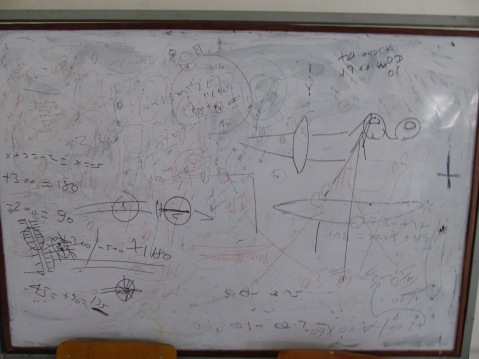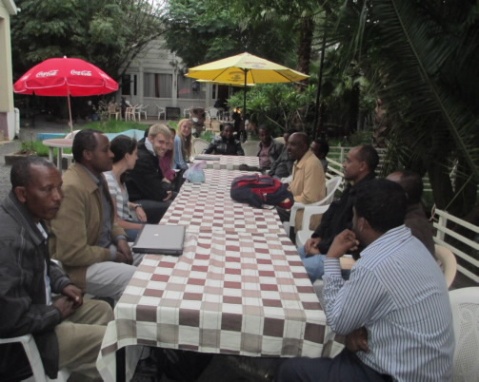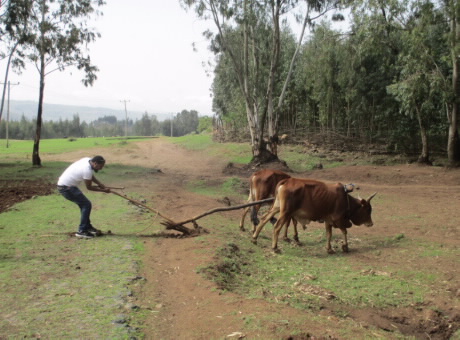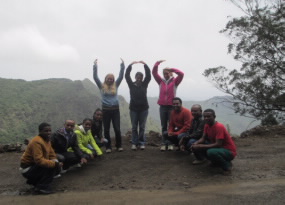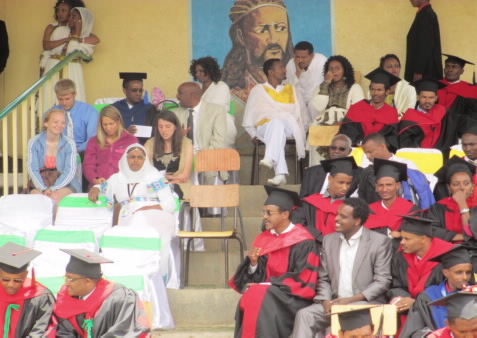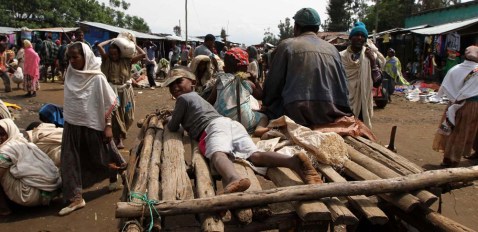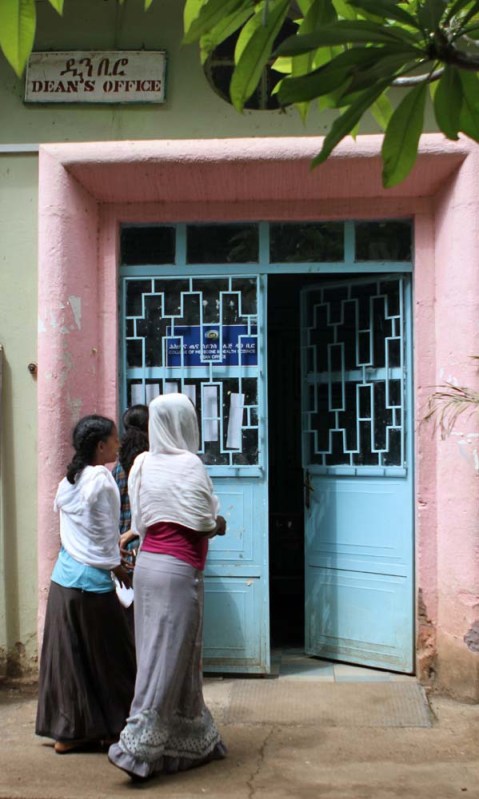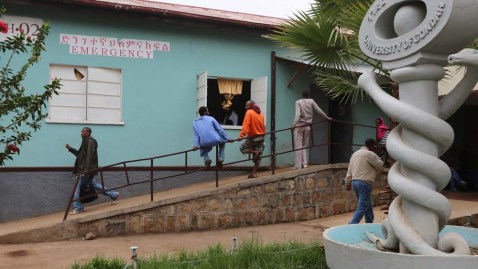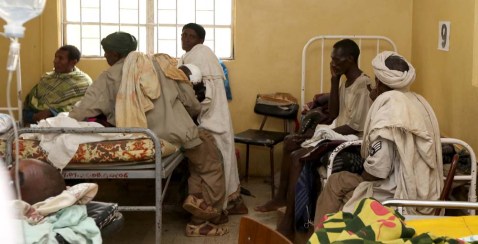Maximum learning, for all partners
By Wondwossen Gebreyes, DVM, PhD
Ohio State College of Veterinary Medicine
As I said in my previous post, we learned many things from each other during this successful Summer Institute. Here are a few of my thoughts on specific topics.
Maximum flexibility and minimum expectations: This became the motto for the team members a couple of days after we arrived. Considering the resource limitations of Ethiopia, the high economic growth and resulting traffic jams, and limitations in communications, one may not be able to plan things well in advance, or keep your lane consistently in driving on the highways, or be able to arrive for meetings on time.
At the end of the day, we always achieve all the goals, and everyone gets to be happy, though not in the most efficient way.
The situation also made me realize how much building capacity in the area of effective communication could improve all the activities we conduct in this partnership, be it neurosurgery, nursing, or environmental health.
Effective communication and filling the gap within our partner institutes in Ethiopia is critical.
However, life in the U.S. made us become very sensitive. We often try to be perfect. Ethiopia was a great venue for most to realize the sky does not fall. It is OK to be a bit late.
Relax, and still achieve our goals!
Equipment. Equipment, Equipment: As we all witnessed during our several meetings at the various health science colleges of the two universities and also read in blogs, one key ingredient missing very much in the hospitals, research, and teaching settings is equipment.
During this trip, I learned first-hand that 44% of the patient cases at the nation’s premier referral hospital, the AAU Black Lion Hospital, were cancer cases. It was sickening to also learn that among these cases, 65% were pediatric. Yes, indeed there is lack of manpower, and so we launched the institute.
The partner universities are also building the physical infrastructures. While these address part of the issue, the lack of equipment is a major impediment for capacity-building. How can one radiotherapy machine can handle such a large cancer case burden for 85 million-plus population?
Equipping laboratories and clinical units remains a major challenge that partners in Ethiopia and Ohio State will have to tackle.
Maximum motivation: I never realized so clearly until this trip what drives my passion in global work, particularly the teaching aspects. Never fully understood what drives me to lecture several hours with only a short tea break and still have the full steam.
I observed my colleague, Dr. Bisesi, give his lecture on environmental health, and I saw the wide open-eyed trainees and their interaction. I noticed the high level of motivation by the trainees. The same was true for my course.
Students were so highly motivated that they even asked me to teach a full day on a Saturday. Some even suggested we keep going on Sunday, but that idea created a bit of a stir. “True,” I said in my heart, “that is a big NO in Ethiopia.”
You have to respect Sabbath day more than molecular epidemiology.
The Ferenji Effect: Ferenji is defined very loosely as “a foreigner,” particularly referring to a rich Caucasian. Its connotation is very positive. Ferenji is often considered as a nice, generous foreigner whose pocket carries endless amount of treasures … well, we all know the truth.
Typically Ferenjis are magnets to Ethiopian kids in urban and rural areas of Ethiopia; they often have chocolates, coins, and all kinds of fun things. At a minimum they have a digital camera to snap kids’ picture and show it back to them. The kids giggle seeing their own image in this small window. They followed Dr. Bisesi and Mr. Harrison as we traveled in a suburb of Addis.
During the Summer Institute, I witnessed the usual hospitality of the university security guards and others giving the due respect to our “guest Ferenjis” and I (the designated local chauffeur) also get a free ride.
Unlike what I stated above, about “Ferenji are magnets to local kids,” kids in the Woreta area acted differently. When we were collecting questionnaires for the rabies project, the kids would run away when they saw our giant, “tall-6-foot-some” great athlete and health science student, Korbin Smith. “They might have considered him as Goliath,” I thought to myself. I also hoped one of those little shepherd kids would not be like Dawit (David). Thankfully, we left the place with all fun and no fighting.
Ohio State in Ethiopia: A great experience overall
By Wondwossen Gebreyes, DVM, PhD
Ohio State College of Veterinary Medicine
It has been wonderful working with all the Ohio State and Ethiopian faculty and students during the One Health Summer activity that run from June 7th to this week.
First off, I am very much proud to be a Buckeye. Everyone from the Buckeye nation (Ohio State) showed wonderful professionalism throughout the Summer Institute.
I heard all positive words from our partners in Ethiopia. Students and faculty from five of our seven health science colleges and also School of Environment and Natural Resources have all been great to work with.
I am also proud to be born Ethiopian. I am sure all my colleagues tasted the ultimate hospitality and motivation both in classrooms and social settings and learned a great deal of variations in traditions.
The commitments from both student trainees and partner administrators has been unsurpassed. It gives me a great pleasure seeing the trainees’ eyes wide open in the various lectures, sharing the Ohio State students’ excitement for service learning (even some requested opportunities for next year before leaving Ethiopia), and reading all the blog posts from our students and faculty members.
Importantly, personally, I also learned few more things about Ethiopia and partnership along the way.
With respect to the scientific/ technical aspects of the Summer Institute, I am confident to say that we achieved the goals – in all aspects: coursework and trainings, pilot projects, and workshops. We were able to impact more than 200 professionals in these courses. And a number of scientific networks and new collaborative partnerships developed. Partner colleges were able to identify areas for further collaboration.
Both the Univeristy of Gondar (photo below) and Addis Ababa University partners as well as other institutes — such as the Ethiopian Health and Nutrition Research Institute (EHNRI) — were excited with the outcome.
It was humbling to hear from the dean of AAU School of Medicine, Dr Mahlet, I quote: “We thought Ohio State would be similar to many, many universities we signed MoU with before and never heard from them again. You made us feel guilty by showing your commitment in a short period of time. Thank you and we are also determined to show our commitment.”
As we move forward, the Ohio State Health Sciences task force will resume its activity in full force. On behalf of the Ohio State Health Sciences One Health task force, thank you to all those who participated in the Summer institute! Some of the upcoming activities will include visits by the Ethiopia partner universities delegation; continued pilot projects on cervical cancer screen-and-treat, rabies intervention, electronic capacity-building, and service-learning clinical activities by neurosurgery and nursing teams. Please stay tuned and follow our blog.
In my next post, I will share some specific thoughts and observations on these activities.
An island monastery in Lake Tana
By Laura Binkley, student
Ohio State College of Public Health and
School of Environment and Natural Resources
During a quick visit to Bahar Dar, we were able to venture into Lake Tana. Lake Tana is the widest lake in Ethiopia and one of the largest lakes in all of Africa. Emptying into the Nile River, it contains several islands. Many of these islands possess ancient monasteries that have been well preserved by the monks. We decided to take a boat tour that would take us out to one of the islands.
Traveling across the lake provided us with fascinating views of the landscape and a strong sense of calm after an intense week of data collection. As we moved through the lake we passed giant pelicans, townspeople cleaning their clothes in the lake, and fisherman fishing in hand-made papyrus boats that seemed impossible to balance in. On our way to the island we crossed paths with the Nile River itself which was a pretty incredible experience.
When we stepped off of the boat onto the island we were surrounded by green. A vast field included papyrus plants and a variety of trees and plants from coffee to mango and banana. We walked down a small mud path towards the monastery where we were greeted by villagers selling fresh fruits and tiny handmade papyrus boat souvenirs among other things.
Once we arrived at the monastery we paid our fee to enter and were then led by an elderly monk to a small stand that he called a museum. He explained that the monastery had been around since the 12th century and then proceeded to show us the contents of the museum which consisted of ancient books, an emperor’s robe, elaborate crosses, and other priceless valuables of the church.
Once our tour of the museum stand was complete the monk lead us to the monastery itself. The monasteries on all of the islands are circular in shape with three main parts. We started at the outer part which consisted of a small wall left open to the outside that surrounded the monastery. Here was where we were to take off our shoes before entering the sacred place.
We were then lead inside to the second part. This section was dark except for the little light that illuminated the walls which were covered in beautiful Christian art pieces. There were also ancient worship drums that were made of clay and covered in hide. We were not allowed to enter the third section where a sacred arc in honor of Mary was hidden. I can only imagine how fascinating it must look.
Once we had a chance to look around for a bit we grabbed our shoes and exited the monastery. We thanked the monk and then headed back down the trail to the boat that had been waiting for us. The boat then headed back towards the mainland again. It was all a very surreal experience that can only be found here in Ethiopia.
Ethics Engagement in Ethiopia
By Karla Zadnik, OD, PhD
College of Optometry
The Summer Institute’s research ethics course chugged along today. I started late, mostly because I didn’t realize most of my students were in the courtyard just outside the classroom in the bright morning sunshine, waiting for me to begin speaking. I lectured on the tenets of the Declaration of Helsinki (OSU faculty—you all remember those, right?) and the ethical use of animals in research (thanks Donna McCarthy!), but the highlight turned out to be the case study discussions.
I presented a case I’d heard at the 2008 Public Responsibility in Medicine & Research meeting. It weaves the tale of an imaginary city, Blovar, which is under siege such that its children are subsisting on an inadequate 400 calories. An entrepreneurial, mythical scientist who studies nutrition and brain function in children appears on the scene to conduct a purely observational study of the children. After carefully reading the case, the course attendees “went to town.” After their small group analysis of the case, I facilitated a discussion of the case. They didn’t need me. There were marked differences of opinion in the class. One attendee drew historical correlates, while another took the role of the Principal Investigator, cautioning the audience to assume that fellow scientists generally want to do a good job. The points made were lively, vehement even, yet collegial. All this before lunch!
The afternoon’s soundtrack was a thunderstorm of biblical proportions that hammered the roof of the classroom and lit up the sky. We all raised our voices in tune with the rain and created a chorus, celebrating the hard, thoughtful work of teaching and learning research-related ethics.
Optometry Pride, Worldwide
By Karla Zadnik, OD, PhD
College of Optometry
Yesterday, Ohio State College of Optometry faculty members, Dr. Dean VanNasdale and Dr. Andrew Emch made their way to the Department of Optometry housed in the International Fistula Training Center at the University of Gondar. The Department’s mission statement reads, “The profession of optometry offers comprehensive eye care services to all mankind. The training program has the philosophy of producing skilled manpower equipped with adequate knowledge, skills and attitude to deliver such eye care services in the most ethical manner, both on the national and international level.” What institution wouldn’t aspire to that?
Hosted by Department Director, Destaya Shiferaw, and several of the faculty, Dr. Andrew and Dr. Dean were struck by many things that surprised them. Dr. Dean found that the optometry bond ran deep, declaring the faculty at UoG “more similar than different to us,” and he was struck by the faculty’s honesty and candor and that they truly held nothing back. Dr. Andrew declared the faculty, “Enthusiastic and proud, yet self-aware.” Unusual characteristics for faculty members, don’t you think?
Destaya and colleagues are clearly altruistic, focused on the larger community and the optometric profession. They had a clear “vision” of the future of optometry in the country and all of Africa, and envision themselves as leaders in public health as it relates to eye care in east Africa. The two teams spent several hours in completely open, engaged communication. They return tomorrow to tour the clinical facilities and discuss strategies for advanced contact lens fitting instruction and practice in the UoG clinic. Stay tuned.
The city of Addis
By Ally Sterman
Student, Ohio State College of Veterinary Medicine
Addis is quite the interesting city full of vibrant city life, u-turns (that aren’t quite legal), coffee shops on every corner, and all the history and  museums you could wish for. Upon our arrival to Addis from Gondar there were a few food items that we were greatly missing. The majority of our previous stay in Gondar was during the fasting season which means no animal products. At a local coffee shop where we stopped for lunch we also stopped for ice cream. This local coffee shop had a very recognizable logo. Upon first glance, we all did a double take to check the name. The sign here is very reminiscent of a similar coffee shop that is also located on every street corner in the U.S.– Starbucks. We felt quite at home here, both the coffee and ice cream were delicious.
museums you could wish for. Upon our arrival to Addis from Gondar there were a few food items that we were greatly missing. The majority of our previous stay in Gondar was during the fasting season which means no animal products. At a local coffee shop where we stopped for lunch we also stopped for ice cream. This local coffee shop had a very recognizable logo. Upon first glance, we all did a double take to check the name. The sign here is very reminiscent of a similar coffee shop that is also located on every street corner in the U.S.– Starbucks. We felt quite at home here, both the coffee and ice cream were delicious.

After our conference we had two days to explore the city. We all supported the Ethiopian economy during our shopping trip down the busy streets of the market. Street vendors were selling everything you could want including both more traditional and less traditional items. That night we went to a local traditional dance club again with some of the OSU professors here for the conference. We were all able to indulge in a local favorite, tej. It is a honey mead made here in Ethiopia. It is served in a special flask called berele. If you didn’t know, you would think you were being served some form of science experiment because the flask looks like something out of a chemistry lab and the tej is an off orange color.
But Addis wasn’t all eating, dancing and shopping. We took the time to visit both Addis Ababa University Museum and the National Museum. At the AAU museum we had the opportunity to see and learn quite a bit about the history of Ethiopia including various traditional medicines used, various tribes and lifestyles present in Ethiopia. There was also a section dedicated to the discovery of coffee and traditional coffee ceremony here in Ethiopia. Another room that particularly caught my eye was the room on musical instruments and their collection of them. We traveled to the National Museum second. The highlight exhibit here was Lucy.

Lucy was discovered in Ethiopia, in Awash valley in 1974. She is thought to be around 3.2 million years old and one of the first bipedal hominid. Seeing her ( both in the standing statue pieces and separate pieces kept apart from the standing statue) was a once in a lifetime chance. Lucy had been in the US for about 6 years but having the chance to see her while in Ethiopia where it is said that humans first lived was a wonderful opportunity.
The initial journey of the University of Gondar-Ohio State rabies project: my perspective
By Tamiru Berhanu Denka, DVM
University of Gondar, Faculty of Veterinary Medicine
I was voluntary and happy when requested to be part of the Rabies Knowledge Attitudes and Practice assessment in and around Gondar. The University of Gondar team was established ahead of the arrival of Ohio State teams, and was made up of lecturers and assistant professors from College of Medicine and Health Sciences (CMHS) and the Faculty of Veterinary Medicine (FVM).
Tdele Atnafu form the School of Pharmacy, and myself form FVM went to two districts: Debark and Woreta, 105 km and 120 km respectively away from Gondar. Dr. Reta Tesfaye (FVM) and Debasu Damtie (CMHS) went to different places in Gondar. The mission of our team in these different places was to contact responsible government bodies and to discuss and debrief the rabies project objective in Gondar particularly, as well as Ethiopia at large, before beginning work.
After the arrival of the Ohio State team, Dr. Wassie Molla, coordinator of the project from UOG, held a meeting to allow the teams from Ohio State and UOG to meet and discuss the interview questions, recording on the ipad, and consent of interviewees at the meeting hall of FVM.
The next step was to start the job– interviewing various individuals and professionals as per the project proposal. Interviewing individuals is not an easy thing to do. However, our prior communication and discussion helped us to interview efficiently. Everyone was welcoming and eager to participate in these interviews. As we continued on, I began to see how important the issue of rabies is, and how much it affects my country. Everywhere we went people stopped their daily activities to meet with us, allowing our groups to finish interviews more quickly than originally anticipated. Due to our efficiency, our teams were asked to take on the challenge of an additional city and we did so in stride. In total we surveyed four cities and conducted approximately 280 interviews in eight days.

Because, it is cultivation season, the periurban community leaders and communities were super busy plowing. At this critical time, it was necessary for us to meet this group of people for the interview. Then we decided to participate in plowing! (Ally, Ohio State 3rd year Vet Med student).
We then went to Addis Ababa to attend the rabies stakeholders workshop, held July 18-19. I am having an immense experience working in a team, appreciate learning about a different culture, and developing more friendships among the Ohio State team and from the University of Gondar as well.
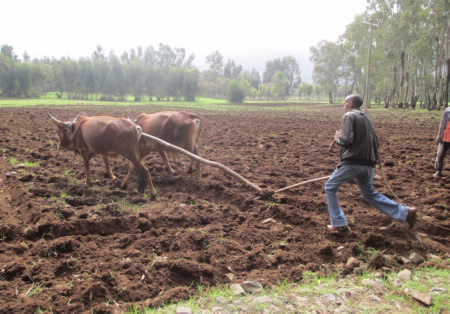
Mr. Berihun (lecturer, Department of Nursing) did well plowing. The farmers were surprised when he started pushing the oxen.

The UOG–OSU rabies project team members after successful interviews of various target groups of the study at Debark, 105 km from Gondar, where UOG is located.

Dr.Baye Molla and the OSU students (Laura Binkely, Karissa Magnuson, Korbin Smith and Allyson Sterman) before getting to attend the graduation ceremony of the UoG on July 6, 2013.
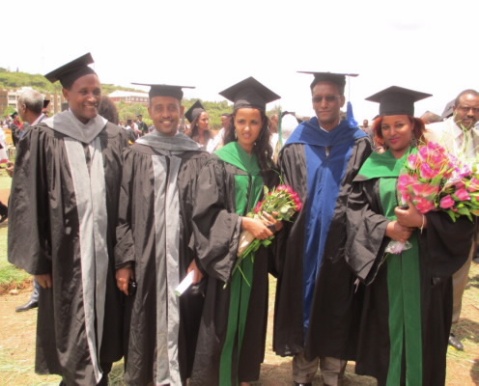
The MPH-VPH program started admitting students in 2012. The program was made successful due to the significant contribution of Ohio State professors. Dr.Molla (Ohio State professor) with two of the first batch of MPH-VPH graduates on June 6, 2013. The MPH-VPH students have green striped graduation gowns.From Left to Right: Dr.Achenef Melaku- Dean of FVM, UOG. Dr. Sileshi Nigatu- Head Department of Veterinary Public Health and Epidemiology.
Rabies In Ethiopia And The Way Forward – Stakeholders Workshop
By Mary Jo Burkhard, DVM, PhD
Ohio State College of Veterinary Medicine
I had the privilege of facilitating a 1.5 day workshop for stakeholders committed to the control and eradication of rabies in Ethiopia. We had approximately 70 registrants including representatives from a number of agencies such as the Ethiopian Health and National Research Institute (EHNRI), Federal Ministries, Center for Disease Control (CDC); partners including conservation, environmental, research and vaccine development groups, as well as a host of faculty and students from the University of Gondor, Addis Ababa University, and The Ohio State University.

Dr. Hailu Mamo, Research Coordinator from ENHRI and Dr. Wondwossen Gebreyes from OSU, two of the meeting organizers working on details before the start of the session.
While not everyone could make it for all of the sessions on both days, we had 45-60 participants in each session which demonstrated the importance of rabies control in Ethiopia. Particularly when you consider that the session was held on a regional campus approximately 23 km outside of downtown Addis Ababa that required navigation through substantial traffic!
We utilized a very powerful workshop format that we at the College of Veterinary Medicine like to call “Focus Forward.” This format included overview presentations, facilitated small group discussions, identification of common recommendations by a “theme team,” and prioritized voting through participant clickers. Dr. Tamiru Berhanu, a veterinarian and lecturer at the University of Gondor (UOG), served as one of our small group facilitators. Dr. Tamiru Berhanu is one of the partners for the rabies collaborations between the University of Gondar and Ohio State. I learned that in Ethiopia, it is common to refer to doctors by their first name, so Dr. Berhanu rapidly became known to me as Dr. Tamiru. Once I figured out the Ethiopian way of addressing people, it became a lot less confusing to sort through our excel spreadsheets of the participant list!
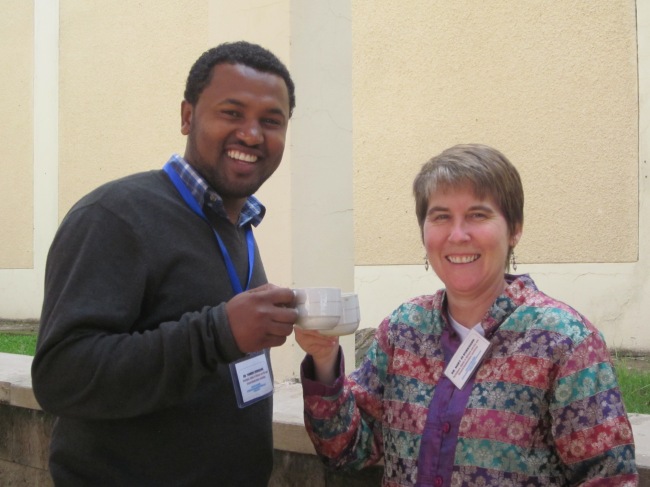
Tamiru Berhanu, a partner for the rabies collaborations between the University of Gondar and Ohio State, and Mary Jo Burkhard.
We had four main topics to cover in the workshop: surveillance and reporting, how to identify people exposed to rabies and develop standards for immediate care of bite wounds, controlling rabies in the dogs and other animals, and education for both urban and rural areas. During the breakout sessions, diverse teams of experts discussed these critical topics. One of the strongest themes that arose in all of the sessions was the need to include traditional Ethiopian healers in the process by combining culturally-accepted, traditional methods of treatment and training of traditional healers with rabies vaccination programs and current medical treatments for bite wound care.
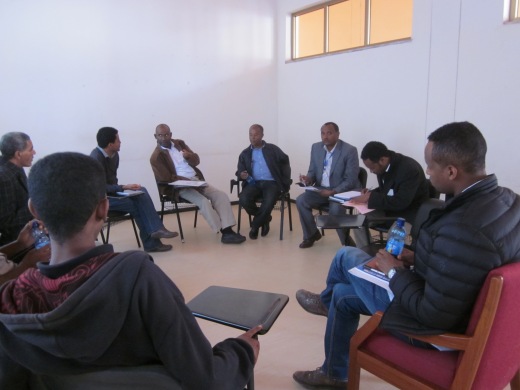
Here, Dr. Debasue Damtie (at right, taking notes on participant responses), a professor from the University of Gondor, leads one of the breakout sessions.
Even though I spent nearly all of my time in the workshop rooms, I learned a lot about Ethiopian culture just from listening to the discussions and hearing the recommendations. However, I am also looking forward to seeing more of Addis Ababa over the next couple of days now that the conference is over and personally experiencing more of the Ethiopian culture!
Scenes from Ethiopia
Photos by Rick Harrison, Ohio State University Communications










